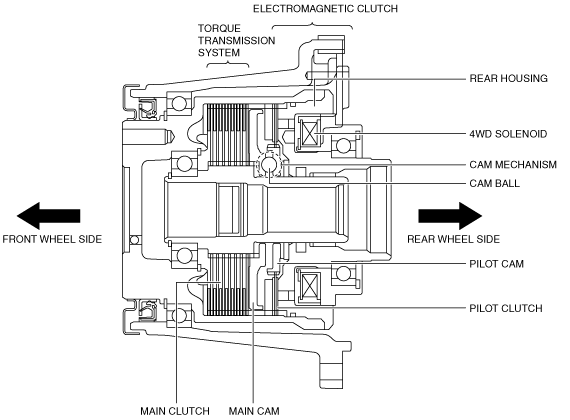ELECTRONIC CONTROL COUPLING
id031800101900
Purpose, Function
• An electromagnetic clutch, which operates smoothly due to the lack influence from the front and rear wheel traction force, has been adopted for the electronic control coupling system.
Construction
• The construction of the coupling enables the torque formed by the pilot clutch to be amplified by the cam mechanism, thus allowing the main clutch to obtain a high degree of torque. Due to this, size and weight reduction of the component parts has been achieved.
• The electronic control coupling basically consists of an electromagnetic clutch, a cam mechanism and a torque transmission system.
• The electromagnetic clutch consists of a 4WD solenoid (electromagnetic coil), rear-housing that forms a magnetic path, pilot clutch, and armature.
• The cam mechanism consists of a pilot cam, balls, and main cam. The torque transmission system consists of a main clutch and hydraulic oil (ATF).
Operation
4WD Solenoid Control Current Is OFF
-
• When the 4WD solenoid control current is OFF, no torque is generated in the pilot clutch because there is no current flowing to the 4WD solenoid.
• At the same time, the pilot cam and the main cam rotate in the same direction via the balls, and the main cam does not exert any push force on the main clutch side. Therefore, the traction from the front wheels is not transmitted to the rear wheels.
4WD Solenoid Control Current Is ON
-
• When the 4WD solenoid control current is ON, current flows from the 4WD CM to the 4WD solenoid, and the coupling operates in the following manner.
-
1. Magnetic flux forms at the electromagnetic coil of the 4WD solenoid.
2. Due to the magnetic flux in the armature, the pilot clutch is suctioned towards the magnetic coil side and made to engage. This causes frictional torque to generate in the pilot clutch.
3. The torque is transmitted to the pilot cam, which is engaged with the pilot clutch.
4. A rotational difference is created between the pilot cam and the main cam. Due to this relative torsion, the cam mechanism operates, transmitting torque from the pilot cam to the ball and then to the main cam. In this way, the push force exerted on the main clutch is amplified.
5. As the main clutch engages, the drive torque from the front wheels is transmitted to the rear wheels.
-
• The amount of push force exerted on the main clutch by the main cam (that is, the strength of the drive torque transmitted to the rear wheels) changes in accordance with the proportion of the force acting upon the pilot cam, engaged with the pilot clutch.
• Therefore, by changing the periodicity of the electric current from the 4WD CM to the 4WD solenoid (ON/OFF rate of the 4WD solenoid = force acting on the pilot cam), the module controls the transmission of drive torque to the rear wheels.
Fail-safe
|
DTC
|
Fail-safe
|
|
P1887:11
P1887:12
P1887:13
P1887:14
|
Control disabled.
|
